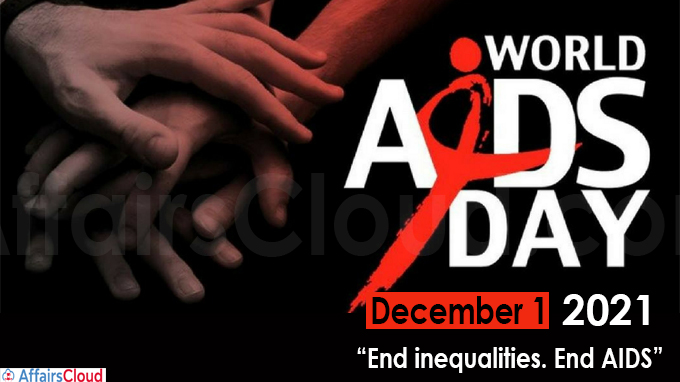 World AIDS (Acquired ImmunoDeficiency Syndrome) Day is annually observed across the globe on 1st December to create awareness about HIV (Human Immunodeficiency Virus), a major public health issue that affects millions of people across the globe.
World AIDS (Acquired ImmunoDeficiency Syndrome) Day is annually observed across the globe on 1st December to create awareness about HIV (Human Immunodeficiency Virus), a major public health issue that affects millions of people across the globe.
- HIV is a virus that attacks the body’s immune system, specifically the white blood cells called CD4 cells.
Symbol: The red ribbon is the universal symbol of awareness and support for people living with HIV.
Theme 2021:
The United Nations(UN), United Nations Programme on HIV/AIDS (UNAIDS), & World Health Organization(WHO) observes World AIDS Day 2021 under the theme “End inequalities. End AIDS” with a focus on reaching people left behind.
According to hiv.gov, the theme of World AIDS Day 2021 is “Ending the HIV Epidemic: Equitable Access, Everyone’s Voice”.
Background:
i.World AIDS Day was initiated in 1987 by James W. Bunn and Thomas Netter, public information officers for the Global Programme on AIDS at the WHO, Geneva, Switzerland.
ii.The first World AIDS Day was observed on 1st December 1988.
- World AIDS Day is one of the 9 days and 2 weeks mandated as the Official Global Public Health Days by the member states of WHO.
Online event: End inequalities. End AIDS. End Pandemics.
As a part of the World AIDS Day 2021 observance, the UN and UNAIDS have organised an online event “End inequalities. End AIDS. End Pandemics”.
Global AIDS Strategy 2021-2026
‘Global AIDS Strategy 2021-2026: End Inequalities. End AIDS.’, is a new approach to use an inequalities lens to close the gaps that are preventing progress towards ending AIDS and sets out bold new targets and policies to be reached by 2025.
Targets and Commitments for 2025:
i.95–95–95 testing and treatment targets achieved among people living with HIV within all sub-populations and age groups by 2025.
- 95% of people within the subpopulation who are living with HIV know their HIV status.
- 95% of people within the subpopulation who are living with HIV who know their HIV status are on Anti Retroviral Therapy (ART).
- 95% of people within the subpopulation who are on ART have suppressed viral loads.
ii.95% of women of reproductive age have their HIV and sexual and reproductive health service needs met; 95% of pregnant and breastfeeding women living with HIV achieve viral suppression; and 95% of HIV-exposed children are tested by 2025.
iii.95% of people at risk of HIV infection use appropriate, prioritized, person-centred and effective combination prevention options by 2025.
Reports:
i.UNAIDS, The Joint United Nations Programme on HIV/AIDS, launched the new World AIDS Day Report 2021 entitled “Unequal, unprepared, under threat: why bold action against inequalities is needed to end AIDS, stop COVID-19 and prepare for future pandemics”.
- The report states that in the next 10 years, around 7.7 million people could die of AIDS-related causes unless leaders address inequalities.
ii.“UNICEF 2021 World AIDS Day Report: Stolen Childhood, Lost Adolescence”, provides global and regional statistical updates on children, adolescents and pregnant women.
- It also features a brief history of the HIV epidemic and its response to children.
- Around 2.78 million children and adolescents are living with HIV and only 54% of them are on HIV treatment as compared to 85% of pregnant women living with HIV.
- 120,000 children, one child every 5 minutes die due to AIDS-related causes.
Key Points:
i.It is estimated that in 2020, around 37,700,000 people across the globe are living with HIV and 73% of people living with HIV received lifelong ART in 2020
ii.In 2020, around 680,000 people have died from HIV-related causes.
About United Nations Programme on HIV/AIDS (UNAIDS):
Executive Director– Winnie Byanyima
Headquarters– Geneva, Switzerland




